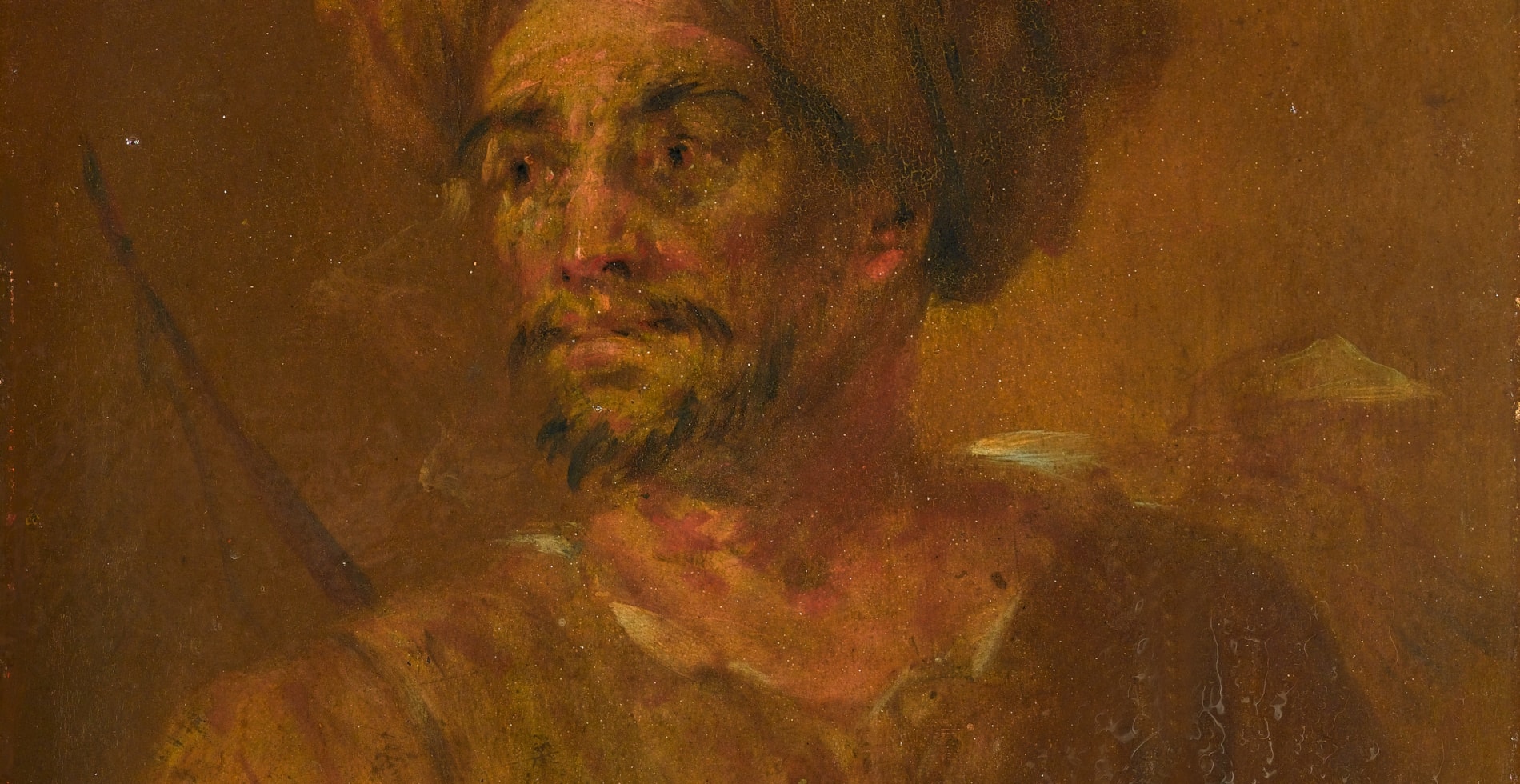enetian School, Eighteenth Century
Study of a Turkish Archer, Bust-Length
oil on panel
22.3 x 17.3 cm (8¾ x 6⅞ in)
A delicate feather pinned atop a turban and the faint outline of a bow identifies this striking figure as a Turkish archer. His dark eyes are cast aside as he gazes intently at something outside the picture plane. Evidently a sketch, the artist had primarily focused on the expression, and rendering, of the facial features and headwear. With delicate, light brushstrokes the wispy beard, moustache and ruddy colouring of the archer are picked out using a limited palette of brown, red and cream. Light gently falls on the wrapped turban, catching the shiny surface of the cabochon jewel and feather, as well as the surrounding material, suggesting it is made of silk. Less attention has been given to the simple tunic the archer wears, which subtly blends in with the muted brown background.
As a vital trading point between East and West, Venice had long-standing associations with the Byzantine and, later, Ottoman Empires, both politically and commercially, and Venetian artists were fascinated by the exoticism of their near eastern neighbours. Artists such as Gentile Bellini (c.1429-1507) worked in the Ottoman court for the Sultan, firmly establishing the artistic connection between Turkish culture and the Venetian school of painting. ‘Orientalism’ in Venice was based on direct contact with the Islamic world, which brought new technological, artistic, and intellectual information to the Republic.
As with previous centuries, painting production in eighteenth-century Venice was often focused around family-run workshops. The most important were those of Sebastiano Ricci (1659-1734) and his nephew Marco (1676-1730), Giambattista Tiepolo (1696-1770) and his sons Giandomenico (1696-1770) and Lorenzo (1736-1776), Canaletto (1697-1768) and his nephew Bernardo Bellotto (1721-1780), and Domenico Guardi (1678-1716) with his sons Giantonio (1699-1760) and Francesco (1712-1793).
Although Study of a Turkish Archer is attributed to an anonymous eighteenth-century Venetian artist, it displays strong stylistic similarities in terms of light brushwork and execution to the work of Giantonio Guardi. Guardi was familiar with Turkish subject matter as among his important patrons was the German aristocrat and collector Johann Matthias von der Schulenburg (1661-1747) who retired in Venice having fought with the Imperial and Venetian armies against the Turks. It is possible that the cultural legacy of this military service led him to commission Guardi to create a series of Turkish-inspired interiors as easel pictures for private decoration.¹
¹ A long series of small scenes of Turkish Life, commissioned by von der Schulenburg are said to have been forty-three in number, according to Guardi’s inventory of 1741, although only twenty-one are now known.
A delicate feather pinned atop a turban and the faint outline of a bow identifies this striking figure as a Turkish archer. His dark eyes are cast aside as he gazes intently at something outside the picture plane. Evidently a sketch, the artist had primarily focused on the expression, and rendering, of the facial features and headwear. With delicate, light brushstrokes the wispy beard, moustache and ruddy colouring of the archer are picked out using a limited palette of brown, red and cream. Light gently falls on the wrapped turban, catching the shiny surface of the cabochon jewel and feather, as well as the surrounding material, suggesting it is made of silk. Less attention has been given to the simple tunic the archer wears, which subtly blends in with the muted brown background.
As a vital trading point between East and West, Venice had long-standing associations with the Byzantine and, later, Ottoman Empires, both politically and commercially, and Venetian artists were fascinated by the exoticism of their near eastern neighbours. Artists such as Gentile Bellini (c.1429-1507) worked in the Ottoman court for the Sultan, firmly establishing the artistic connection between Turkish culture and the Venetian school of painting. ‘Orientalism’ in Venice was based on direct contact with the Islamic world, which brought new technological, artistic, and intellectual information to the Republic.
As with previous centuries, painting production in eighteenth-century Venice was often focused around family-run workshops. The most important were those of Sebastiano Ricci (1659-1734) and his nephew Marco (1676-1730), Giambattista Tiepolo (1696-1770) and his sons Giandomenico (1696-1770) and Lorenzo (1736-1776), Canaletto (1697-1768) and his nephew Bernardo Bellotto (1721-1780), and Domenico Guardi (1678-1716) with his sons Giantonio (1699-1760) and Francesco (1712-1793).
Although Study of a Turkish Archer is attributed to an anonymous eighteenth-century Venetian artist, it displays strong stylistic similarities in terms of light brushwork and execution to the work of Giantonio Guardi. Guardi was familiar with Turkish subject matter as among his important patrons was the German aristocrat and collector Johann Matthias von der Schulenburg (1661-1747) who retired in Venice having fought with the Imperial and Venetian armies against the Turks. It is possible that the cultural legacy of this military service led him to commission Guardi to create a series of Turkish-inspired interiors as easel pictures for private decoration.¹
¹ A long series of small scenes of Turkish Life, commissioned by von der Schulenburg are said to have been forty-three in number, according to Guardi’s inventory of 1741, although only twenty-one are now known.





 contact
contact contact
contact +44 20 7313 8040
+44 20 7313 8040









